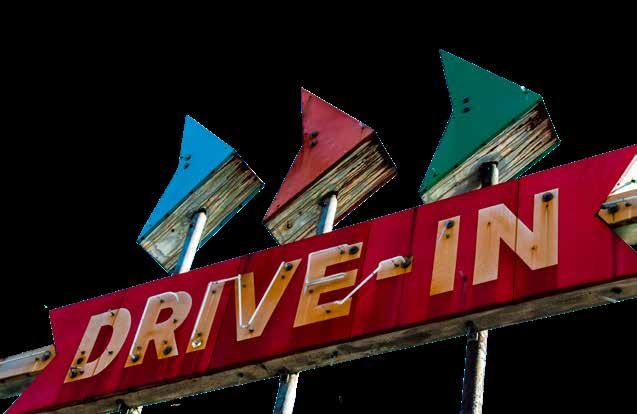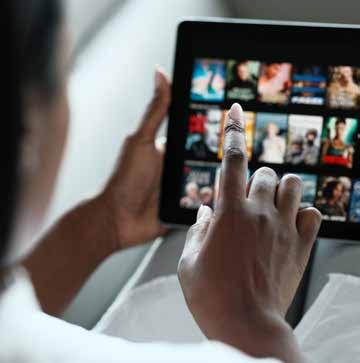
9 minute read
THE BUSINESS OF THE ARTS
By Meaghan Branham
Creating and Consuming Culture in a Pandemic
Advertisement
MEAGHAN BRANHAM is the managing editor for i4 Business, where she oversees the company’s digital media strategy, handles client relationship marketing for the print and digital magazines, and serves as one of the lead writers.
In the 1400s, as Italy emerged from a time of uncertainty and fear brought on by the devastation of the plague, people found themselves seeking comfort in art, which allowed them to revel in celebrations and contemplations of life. That period became known as the Renaissance. Some predict a similar transformation in our own world in the coming years.
That prediction may not be too far off. In the past year, people found themselves dealing with anxiety, uncertainty and stress, and many had more time than usual on their hands. People dove into new hobbies, new ways to express themselves or new ways to keep busy in the midst of a global trauma. They turned to sewing, knitting, painting, interior decorating, music, photography and many other activities.
There’s science to back up that urge to create: According to a 2016 study at Drexel University, just 45 minutes of making art can significantly lower levels of cortisol, a hormone made in response to danger — or to the stress of, say, a global pandemic.
That we need the arts should never be called into question, especially after a year when so many of us found solace in them. The question should be, how have the arts been hit hardest, how can we help them, and what will they look like moving forward? Here, we’ll take a look at some of the hardest-hit sectors of the arts and what COVID-19 changed for them.
Museums
The world of art galleries, museums and art fairs faced an especially difficult challenge in the past year. Some estimates paint a grim picture of their future, predicting that roughly one-third of U.S. museums may have to permanently close their doors as a result of the pandemic. But it’s not all bad news, and most of our art sanctuaries aren’t going out without a fight.
Even while closed, Central Florida’s museums and galleries pivoted quickly. Institutions like the Cornell Fine Arts Museum at Rollins College, the Albin Polasek Museum & Sculpture Gardens and the Charles Hosmer Morse Museum of American Art, all in Winter Park, began offering virtual tours or transferring their audio tours online. The Orlando Museum of Art started its #MuseumFromHome program, offering materials online like printables and virtual discussions with artists to allow patrons a new version of an immersive experience. Outdoor spaces with exhibits like Leu Gardens implemented social distancing and mask requirements.
It proved effective, with many people more than willing to show up. From the comfort of their homes, they explored the halls of museums with the same


focus and reverence they would show in person. They engaged with the art in new ways, free to talk excitedly with friends and family next to them about the works, or to pull up a new tab and dive into an artist’s repertoire. The activity has spiked a desire for them to learn more and, when they can, to return to these places with a renewed gratitude for the chance to have an in-person interaction with the art. Fifty-nine percent of those surveyed in a 2020 Artnet News survey say they plan to visit museums before any other art venue post-lockdown.
Film Industry
Can you remember the last movie you saw in a theater? It was most likely more than a year ago. And in the time since, the business of film has seen fundamental changes in every part of the industry.
For almost the entirety of film’s history, a studio blockbuster was required to play in theaters for three months before its home entertainment launch, according to a Variety report. When temporary closures forced movie-goers away from theaters, home entertainment was suddenly the only option for film distributors that didn’t want to postpone releases. Today, many can’t imagine life without these streaming services, statistics show. According to Ofcom’s annual study into UK media habits reported in a BBC.com article, “People watched streaming services, such as Netflix, Amazon Prime Video and Disney+, for one hour 11 minutes per day, and 12 million people joined a service they hadn’t used previously.”
AARP and its membership of people age 50 and older began leaning into this new form of audience engagement, offering programs like “Movies for Grownups” screenings. These exclusive showings of movies selected to spotlight writers, actors and directors who are over 50 gained even more traction during the pandemic, when AARP was able to secure films like The Mauritanian starring Jodie Foster.
Some tried to outrun the clock on COVID-19 restrictions, only to find that audience anticipation was dwindling. Would-be blockbusters like Disney’s Mulan and DC’s Wonder Woman 1984 still ended up on these platforms, circumventing the problem of multiperson households renting one film by charging the cost of three to four traditional theater tickets. Mulan alone made a total of more than $35 million on its opening weekend. According to screenrant.com, all of that revenue went straight to The Walt Disney Company as net profit, without the hindrance of distribution fees.
At the same time, the drive-in theater experienced a resurgence. While drive-ins weren’t immune to the disruptions in film supply chains, they could turn to showing classics, a strategy that worked perfectly with the dose of nostalgia these theaters offered. The Silver Moon Drive-In in Lakeland and the Ocala Drive-In were able to quickly adapt to the pandemic demand, while other venues improvised to use existing space to create a kind of pop-up drive-in: Old Town Kissimmee, SeaWorld Orlando, and even a Walmart in Winter Haven.
Central Florida’s theaters, like others, are doing their best to adjust. Local venues like the Enzian, Orlando’s art house theater, have been working hard to keep their doors open. When the pandemic began, the Enzian shifted much of its content online, making it available for people to pay to stream the movies they would otherwise see in person. As some began to open their doors, the Enzian followed suit, with limited capacity enforced through socially distanced seating and safety guidelines like a contactless menu at each table. The theater even installed a new air-conditioning unit with UV filtration, designed to reduce the risks of COVID-19 transmission even further.
Film festivals were also forced to adapt, switching to an F

Charles Hosmer Morse Museum
#MuseumFromHome
online streaming model that would allow for a live audience. Q&A’s typically held in person before or after a screening became Facebook Live events. These shifts, exhibitor relations analyst Jeff Bock predicted in Variety, aren’t just “a reboot.” Instead, “It’s a rebuild of the theatrical model.”
Locally loved events like the Global Peace Film Festival, which is based in Orlando, took their lineups to the digital world. Sanford’s “Love Your Shorts” short film festival, which kicked off on February 12, 2021, offered audiences the chance to watch from home or attend in person, keeping in mind limited capacity in the Wayne Densch Performing Arts Center. The Florida Film Festival, which started August 7, 2020, went ahead with screenings held at the Enzian, along with offering much of its content through its virtual festival. The event limited screenings online to a capacity of 100 viewers, mimicking the actual capacity of a physical theater.
Still, many in the arts world find themselves struggling to adapt and in need of help from the community to ensure their preservation. As distributors push back release dates or offer the same content on streaming platforms, audiences are not turning out the way many had hoped. Foundations like United Arts of Central Florida, a fundraising agency for the arts, are helping as well. In December 2020, United Arts began matching 15% of any donation made to the Enzian through its organization.
Live Music and Theater
Live performances like theater and music were among the hardest hit by the COVID-19 pandemic. Performing arts centers and music venues small and large were the first to shut their doors, and many expected they would be the last to reopen. A BBC report estimated that musicians would lose two-thirds of their income as a result of COVID-19.
In response to the alarming numbers, many venues and artists have turned to streaming their concerts or releasing footage of past performances, garnering an encouraging response from audiences.
As early as April 2020, virtual concerts like the One World Together At Home event showcased performers including Taylor Swift, Lady Gaga and Kacey Musgraves. In October 2020, the fourth annual Tom Petty Birthday Bash went virtual, with musicians performing from wherever they were. In January and February 2021, Glasgow’s annual folk and world music festival Celtic Connections
went online, drawing audiences from more than 60 countries who bought more than 27,000 tickets and festival passes for a show that spanned 19 days.
Meanwhile, musicians from the Foo Fighters to Billie Eilish to John Legend to Phoebe Bridgers to Miley Cyrus and every genre in between put on shows from their living rooms. Local acts followed suit, and soon venues and acts like Blue Bamboo Center for the Arts, Bok Tower Gardens and the Orlando Philharmonic were hosting their own watch-from-home performances.
With time to regroup and prepare, larger shows were organized. Late in 2020, the Dr. Phillips Center for the Performing Arts announced the Frontyard Festival: a six-month-long event where acts could perform on the front yard of the center for an audience of socially distanced fans in individual “pods” of up to four people. The festival began in December 2020 and has been going strong since. As public spaces reopen and we learn how to more safely navigate them, it looks like live performances are set to come back stronger than ever, and dates are beginning to be announced for 2022 shows. Acts like The Weeknd, Elton John and Gaelic Storm are set to grace Orlando again.
Live theater was left in a similarly difficult situation. Half of the jobs in that industry were lost between April and July 2020, according to a 2020 study by the Brookings Institution. Quickly, theaters like Orlando Shakes and the Orlando Repertory Theatre pivoted to online learning tools and classes, adapting curriculum to sustain revenue through that channel until they could find a way to resume performances. It didn’t take long, and soon outdoor performances with safety protocols in place were in the works in spaces like the Lake Eola bandshell. The Shakespeare theater launched online plays starting in October with a one-man performance about the macabre world of poet Edgar Allan Poe. Thanks to their quick thinking, many local theaters like the Shakes, the Rep, and Mad Cow Theatre survived 2020 and are setting up for upcoming seasons or in the middle of producing their 2021 shows.
Light at the End of the Tunnel
As museum doors were shuttered, concert tickets were refunded, and movie premieres were postponed, people found themselves wondering: “Could the arts be a casualty of COVID-19?”
The answer, to the relief of many, seems to be a resounding refusal to let our artists fade away. Instead, artists and their works have done what they’ve always done: Reflect our realities, guide us through hard truths and — paradoxically — help us escape from reality.
Mediums and messages will continue to evolve, as they have throughout all of human history. The way we make, view and support the arts might look different post-COVID, but there seems to be a unanimous understanding that we will always need them. Ɏ










